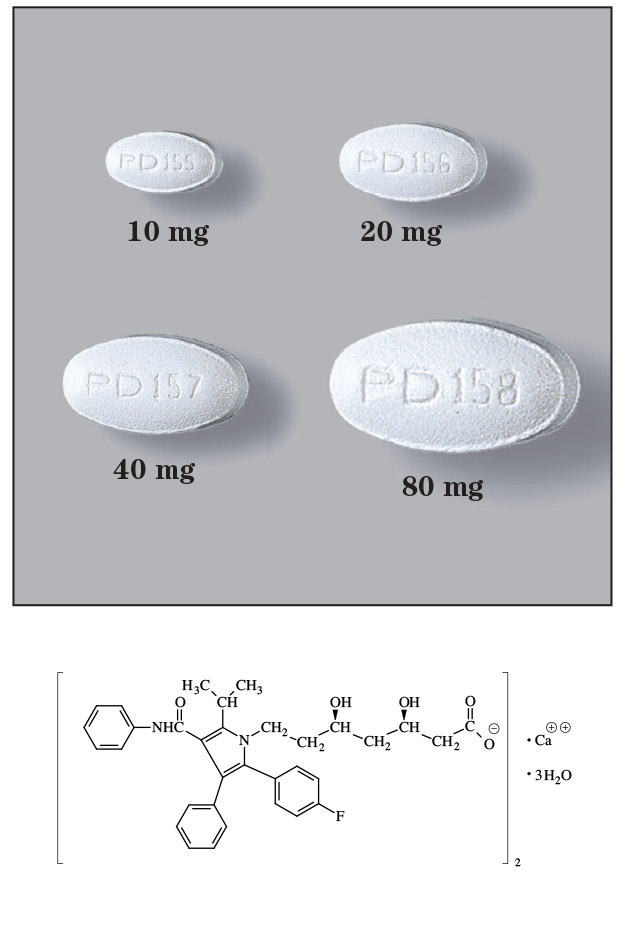
ə/tōr’ və/sta’ tin
Brand Name: Lipitor®
• Generic AvailableCommon Dosage Forms:
- Tablets: 10 mg, 20 mg, 40mg, and 80 mg
FDA Indications/Dosages:
- As an adjunct to diet to reduce elevated total cholesterol, LDL-C, apo B, and triglyceride levels and to increase HDL-C levels in patients with primary hypercholesterolemia (heteroztgous familial and nonfamilial)*, mixed dyslipidemia (Frederickson Types IIa and IIb), in patients with elevated serum triglyceride levels (Frederickson Type IV), and in primary dysbetalipoproteinemia (Frederickson Type III) and in patients with multiple coronary heart disease risk factors to reduce the risk of myocardial infarction, angina and revascularization procedures: Begin with 10 mg once a day, with or without meals. The dosage range is 10 mg to 80 mg per day, given at any time of the day.
- To reduce the risk of non-fatal myocardial infarction, fatal and non-fatal stroke, angina, revascularization procedures, and hospitalization for congestive heart failure in patients with clinically evident coronary heart disease: The dosage range is 10 mg to 80 mg per day, given at any time of the day.
- To reduce total cholesterol and LDL-C in patients with homoozygous familial hypercholesterolemia as an adjunct to other lipid-lowering treatments: 10 to 80 mg per day.
- As an adjunct to diet to reduce total-C, LDL-C, and apo B levels in boys and postmenarchal girls, 10 to 17 years of age, with heterozygous familial hypercholesterolemia if after an adequate trial of diet therapy LDL-C remains ≥ 190mg/dL or ≥160 mg/dL AND there is a positive family history of premature cardiovascular disease or two or more CVD risk factors are present: Start with 10 mg per day and titrate to a maximum of 20 mg per day in 4 week intervals.
Monitor: LFT, Lipid Panel
Pharmacology/Pharmacokinetics:
Atorvastatin is a selective, competitive inhibitor of HMG- CoA reductase. This enzyme is responsible for the conversion of HMG-CoA to mevalonate, an early rate- limiting step in the synthesis of cholesterol. It also increases the number of LDL (low density lipoprotein) receptors on the surface cell, thereby increasing uptake and catabolism of LDL. Atorvastatin reduces total cholesterol, LDL-C, apo B (apolipoprotein B), VLDL-C (very low density lipoprotein), and triglycerides and produces variable increases in HDL and apolipoprotein A-
Atorvastatin is ≥98% bound to plasma proteins. It may be metabolized by cytochrome P450 3A4 system. Its metabolites are as effective as the parent drug; excretion occurs primarily in the bile. The half-life of inhibitory activity for HMG-CoA reductase is 20-30 hours.
Drug Interactions:
May increase digoxin levels. Coadministration with the any of the following may increase the plasma levels of atorvastatin; gemfibrozil, grapefruit, nicotinic acid, itraconazole, erythromycin, clarithromycin, azole antifungals, protease inhibitor combinations (ritonavir plus saquinavir, lopinavir plus ritonavir) and cyclosporine.
Contraindications/Precautions:
Contraindicated during pregnancy or lactation. Also contraindicated in patients with active liver disease or unexplained persistent elevations of serum transaminases. Use with caution in patients with any amount of liver dysfunction and in patients whom consume large amounts of alcohol. It is recommended that liver function tests be performed every 6 weeks during the first 3 months of therapy and periodically thereafter. Increases in serum transaminases of more than 3 times the normal level should warrant discontinuation. If serum transaminase levels do not decrease upon discontinuation, a liver biopsy should be considered. May cause myopathy or rhabdomyolysis. Myopathy should be considered in any patient experiencing diffuse myalgias, muscle tenderness or weakness, or marked elevation of CPK. Pregnancy Category X.
Adverse Effects:
The most frequent adverse effects are constipation, diarrhea, dyspepsia, and flatulence (~2%). Contact physician if symptoms of myopathy occur (e.g.,muscle pain or tenderness, especially if accompanied by malaise or fever).
Patient Consultation:
- Closely follow prescribed diet. Patients should be placed on a cholesterol-lowering diet before drug therapy and should continue on this diet during treatment.
- Avoid overexposure to sunlight due to possibility of photosensitivity. Use a sunscreen and appropriate clothing until the level of sensitivity is determined.
- Do not become pregnant during therapy. If pregnancy occurs or is suspected, discontinue medication and consult a physician.
- Limit alcohol intake during therapy.
- Store in a cool, dry place away from sunlight and children.
- If a dose is missed, take it as soon as possible. If more than 8 hours has lapsed between the time the dose was to be taken, skip it and return to normal dosing schedule.
- Contact a physician if symptoms of myopathy occur (e.g.,muscle pain or tenderness, especially if accompanied by malaise or fever).